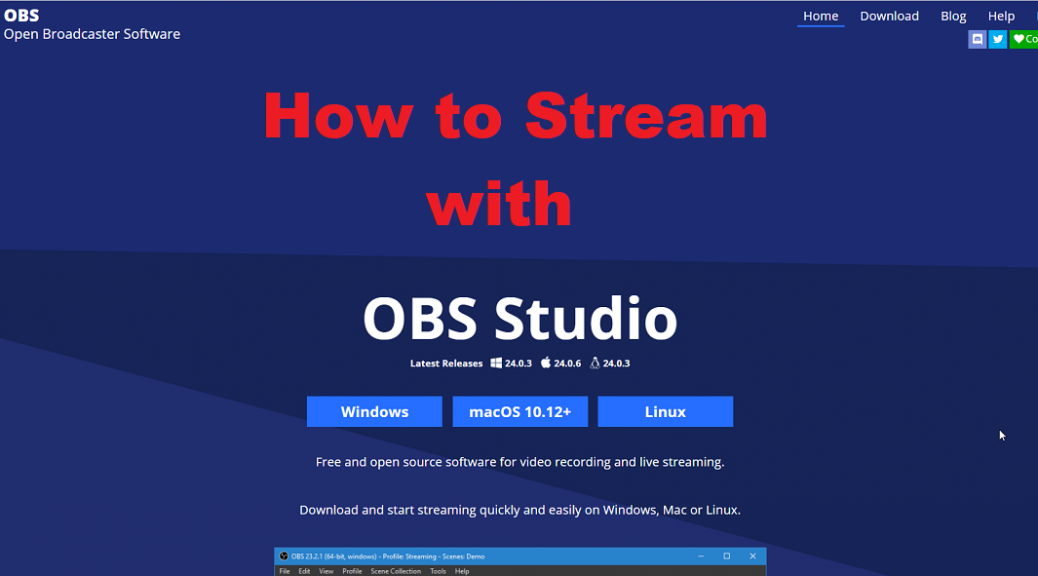I mentioned online that I finally figured out how to stream and that it isn’t difficult, there’s just a lot of moving parts. I had one person ask me to share what I know. You can see the companion YouTube video here.
First, let me be clear that I am not an expert and have only live streamed on Twitch a half dozen times at most, and never for more than a few minutes until today, when I streamed for an hour. I recorded three new episodes for my YouTube series, Roll20 For The Absolute Beginner.
It was not the best looking stream, nor the best sounding. Proper lighting and audio are two entirely different topics for which I am not the best example. I figured out how to make it work, I didn’t say I do it well. As with anything, practice and familiarity, plus an effort to improve will yield results.
In my experience, you want to use OBS, Open Broadcaster Software. It is open source freeware that is quite sophisticated and can handle both recording your screen, or your webcam, or both, plus the webcams of others.
I have long wanted to record games I run online. Mostly for playback to analyze my GMing or to record how I explained something because I really liked how I said it, but can’t recall the specific words from memory. But getting the audio from other players to record at a volume one can easily hear always seemed always to be missing a step.
Between a combination of a few different videos and my own trial and error, I finally hit on the right formula to record the audio of another person from an online meeting software. This also allowed me to make sense of how to get the right hardware settings on my PC and get the right results for recording a small overlay with my webcam displayed over my web browser displaying Roll20 or other browser window.
I recorded about a half dozen short videos and played them back until I got the sound right. For me, I found that using the headset speakers and microphone prevented the microphone from picking up the sound from external speakers and causing an echo. There is probably a way to do sound so that it doesn’t cause an issue between all the pieces, but this was a solo operating for me to do streaming.
The same settings that allow me to stream a browser tab will also let me stream a video game. Again, none of this is hard, it is just a matter of figuring out the right combination of hardware settings and settings in OBS to get the results you want. Once you get it working, improving the lighting and sound is the next natural progression. There is a lot of information online about those topics which are beyond the current scope.
The hardware settings are going to vary by Operating System. Windows 7 is now outdated and no longer updated by Microsoft. Windows 10 is different in how you get at the hardware than Win7. Linux may vary on the GUI controls that are available with different window managers, or the command line. MAC OS, since it is a UNIX variant, should have both a GUI and command line option for configuring sound and microphones.
Once you have the hardware defaults set correctly, you can use the settings in OBS. OBS can rely on the default speakers and microphone, or you can specify the exact one of each you wish to use.
One can live stream a game or other activity to Twitch, YouTube, or other streaming service.
One can also use it to simultaneously record for editing and uploading to YouTube or other VOD (Video On Demand) service.
Obviously, this means that one can also either stream and not record it, or record it and not live stream it.
If you want to live stream an RPG, I recommend the three videos that Jacob Noorman of the Mini Terrain Domain YouTube channel put together.
Zoom is an online conferencing service that has a free option that is unlimited for 2 people and limited to 40 minutes for 3 to 100 people. There are two tiers of paid service that allow hours of use. Only one person, the host, needs a paid account. One could just as easily use Skype or other similar service.
How to Stream D&D and Other RPGs using OBS & Zoom
https://youtu.be/AvmdQaToSZw
- Download OBS (free, open source): https://obsproject.com/download
- Download Virtual Cam plugin for OBS (free download): https://obsproject.com/forum/resources/obs-virtualcam.539/
- Download Zoom (free download, paid premium features): https://zoom.us/download
How to Make Overlays and Stream Assets (Part 1)
https://youtu.be/3EAKW1lfucE
How to Make Overlays and Stream Assets (Part 2)
https://youtu.be/xN6YDCsfDTU


